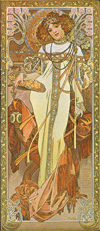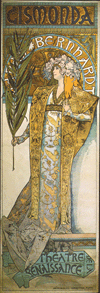
Alfons Maria Mucha was born on 24 July 1860 in
Ivančice in Moravia (also known as Eibenschitz). His father worked
as an usher for the local court and was horrified at the idea that
his youngest son would become an artist – he was intended instead
for the priesthood. As a compromise, he worked for two years as a
court scribe in Ivančice, before becoming an apprentice scene
painter in Vienna in 1880. When this
employment folded, he became court painter and restorer for Count
Carl Khuen in the small town of Mikulov
(Nikolsburg) in South Moravia. This led to an offer to
study in Munich and Mucha departed there in
1885. After two years
study in Germany
the Count encouraged Mucha to continue his studies in Paris at the
Académie Julian and later the Académie
Colarossi.
Having been so well set up, the termination of his
allowance from the Count in 1899 led to commercial work as an
illustrator to put bread on the table. His big break came on
Christmas Eve 1894.
Mucha was at the Lemercier printing works correcting proofs
for a friend when the famous actress Sarah Bernhardt
telephoned. She was
unhappy with the posters which had been prepared to publicise her
appearance in the play Gismonda and demanded that
new posters be ready by New Years Day. As sole artist in the
immediate vicinity, Mucha was handed the commission. The poster was a success and
catapulted Mucha to notice.
Bernhardt was so happy with the work that she negotiated a
six-year contract with Mucha during which time he produced nine
posters for her.

During this phase, the printer Champenois secured an
exclusive right to print Mucha’s work in return for a (pretty
generous) salary for the painter. While many of Mucha’s works
known to us were advertisements, there are also the panneaux decoratifs,
essentially the same sort of picture but without bespoiling text,
printed on satin. These arose
out of the Champenois relationship and were as numerous as they were
commercially successful. Champenois believed in getting his
money's worth. Mucha became increasingly overwhelmed
with the demands of this work and found less and less time to
oversee and correct the printings. The high quality satins are
quite rare and a large quantity of surviving Mucha work would have
been cheaper editions printed on paper, discolouring over time and
probably off-register on creation.
Look I know there's a heap of stuff on the InterWeb
already about Mucha and I'm not going to add much by way of
scholarly research; but trust me, I'm heading somewhere with this
over the next couple of weeks....
to
be continued....
| 
